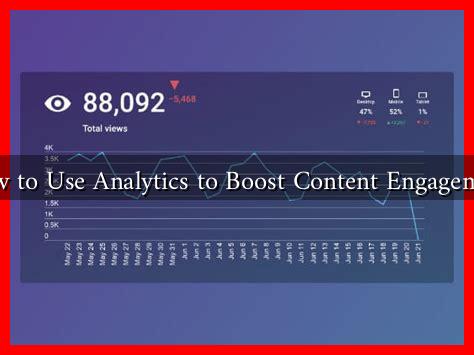-
Table of Contents
How to Use Analytics to Boost Content Engagement
In the digital age, content is king, but engagement is the crown. Creating high-quality content is only half the battle; understanding how to engage your audience effectively is crucial for success. Analytics plays a pivotal role in this process, providing insights that can help you refine your content strategy and boost engagement. In this article, we will explore how to leverage analytics to enhance content engagement, supported by examples, case studies, and relevant statistics.
The Importance of Content Engagement
Content engagement refers to how users interact with your content, including likes, shares, comments, and time spent on a page. High engagement levels indicate that your audience finds your content valuable and relevant. According to a study by HubSpot, companies that prioritize content marketing experience 13 times more ROI than those that do not. Therefore, understanding and improving engagement is essential for maximizing your content’s effectiveness.
Understanding Your Audience Through Analytics
Before you can boost engagement, you need to understand who your audience is and what they want. Analytics tools can provide valuable insights into audience demographics, preferences, and behaviors. Here are some key metrics to consider:
- Demographics: Age, gender, location, and interests can help tailor your content to meet the needs of your audience.
- Behavior: Analyze how users interact with your content, including which pages they visit and how long they stay.
- Traffic Sources: Understanding where your audience comes from (social media, search engines, referrals) can help you focus your marketing efforts.
Tools like Google Analytics and social media insights can provide this data, allowing you to create a more targeted content strategy.
Utilizing Engagement Metrics
Once you have a clear understanding of your audience, the next step is to focus on engagement metrics. Here are some key metrics to track:
- Page Views: Indicates how many times your content has been viewed.
- Average Time on Page: A longer time suggests that users are finding your content engaging.
- Bounce Rate: A high bounce rate may indicate that your content is not meeting user expectations.
- Social Shares: The number of times your content is shared on social media can indicate its relevance and appeal.
By regularly monitoring these metrics, you can identify which types of content resonate most with your audience and adjust your strategy accordingly.
Case Study: The Power of A/B Testing
A/B testing is a powerful method for optimizing content engagement. By creating two versions of a piece of content and measuring their performance, you can determine which version resonates more with your audience. For example, BuzzFeed frequently uses A/B testing to refine headlines and images, resulting in significant increases in click-through rates. In one instance, a simple change in a headline led to a 20% increase in engagement.
Leveraging User Feedback
Analytics can also help you gather user feedback, which is invaluable for improving content engagement. Consider implementing the following strategies:
- Surveys: Use tools like SurveyMonkey to gather direct feedback from your audience about what they like and dislike.
- Comments and Reviews: Monitor comments on your blog or social media to understand audience sentiment.
- Heatmaps: Tools like Hotjar can show you where users click and scroll, helping you identify areas for improvement.
By actively seeking and analyzing user feedback, you can make informed decisions that enhance engagement.
Conclusion: The Path to Enhanced Engagement
In conclusion, using analytics to boost content engagement is a multifaceted approach that requires understanding your audience, tracking key metrics, and continuously refining your strategy. By leveraging tools like Google Analytics, A/B testing, and user feedback, you can create content that resonates with your audience and drives engagement. Remember, the ultimate goal is not just to create content but to foster a community of engaged users who find value in what you offer. As you implement these strategies, you will likely see an increase in engagement, leading to greater success in your content marketing efforts.
For more insights on content marketing and analytics, consider visiting HubSpot’s Marketing Statistics.

